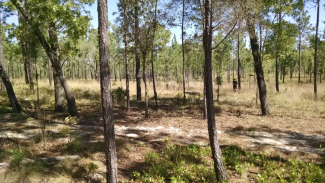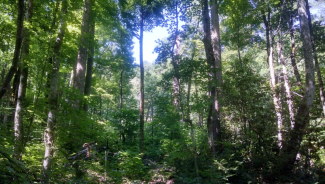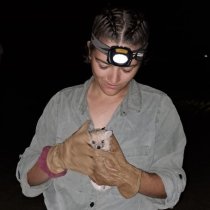Case Study
Examining the Drivers of Forest Productivity
June 11, 2020
What makes some types of forests more productive than others? Asked another way, why do some forests capture more carbon from the atmosphere through photosynthesis than others?
Chris Gough, an associate professor of biology at Virginia Commonwealth University (VCU), is using data from the NEON program to explore relationships between forest structure, biodiversity, and other characteristics and their ability to sequester carbon. His collaborative work with PIs from the University of Connecticut and Purdue University was recently published in Ecology: “High Rates of Primary Production in Structurally Complex Forests.”
Photosynthesis, Carbon Sequestration, and Net Primary Production
“Net Primary Production,” or NPP, is the rate at which all plants within an ecosystem convert sunlight into usable chemical energy and carbon-rich biomass. During photosynthesis, plants use energy from the sun to convert carbon dioxide (CO2) and water into sugars that fuel their growth and supply the backbone of all organic molecules. In this way, carbon from the atmosphere is transformed into biomass. The oxygen we breathe is released back into the atmosphere as a bioproduct of photosynthesis.
When more photosynthesis occurs in an ecosystem, more carbon is taken out of the atmosphere and sequestered in plant tissues. Highly productive ecosystems are valuable “carbon sinks,” creating a net reduction in atmospheric carbon. Forests are especially valuable as carbon sinks because trees live a long time, keeping carbon sequestered in biological tissues rather than quickly releasing them back into the atmosphere. Globally, temperate forests are estimated to store between 99-159 petagrams of carbon, making them one of the most important terrestrial carbon sinks.
However, the factors that influence NPP—and the amount of carbon a forest is able to capture and store—have not been fully explained. Chris and his coauthors wanted to determine which characteristics of temperate forests were correlated with high levels of NPP.
Measuring Forest Structure and Net Primary Production
The study looks at several measures of forest structure and tree species diversity across ten NEON field sites featuring temperate forests in the eastern U.S. These sites include Bartlett Experimental Forest (BART), Great Smoky Mountains National Park (GRSM), Harvard Forest (HARV), Mountain Lake Biological Station (MLBS), Ordway‐Swisher Biological Station (OSBS), Smithsonian Conservation Biology Institute (SCBI), Smithsonian Environmental Research Center (SERC), Talladega National Forest (TALL), Treehaven (TREE), and University of Notre Dame Environmental Research Center (UNDE).The goal was to see how different indicators of ecosystem structure and biodiversity are correlated with NPP and to determine the characteristics that make a temperate forest more or less productive.

Ordway-Swisher Biological Station (OSBS), located in central Florida, is a pine savanna ecosystem populated primarily by longleaf pine (Pinus palustris) with occasional occurrence of turkey oak (Quercus laevis). The forestry plot above, part of NEON’s long-term monitoring efforts at the station, is representative of the open nature of the pine savanna system—low in both structural and biological complexity, resulting in low rates of productivity. Photo credit: Jeff Atkins.
Chris says, “The complexity metrics we are capturing give us important information about species diversity, leaf cover, and forest structure. The goal is to combine these into one useful composite measure that will be a strong predictor of carbon sequestration.”
The team measured forest structure using portable canopy LiDAR systems carried by researchers as they walked through the forest. LiDAR (Light Detection and Ranging) is a remote sensing technology that uses a rapidly firing laser beam to scan an environment and create a detailed 3D picture of its structure. (The NEON program also generates LiDAR data from above using the Airborne Observation Platforms.) They used the LiDAR data to look at a number of canopy traits, including vegetation density/area, height, cover, and canopy structural complexity. This provides a picture of how much vegetation is present at different vertical levels of the forest and how much area is covered by leaves (“leaf area index”). They also looked at measures of tree species diversity, including the number of different species present and the relative abundance of different species, derived from NEON biodiversity data. (For more on the LiDAR methods, see “Quantifying Vegetation and Canopy Structural Complexity from Terrestrial LiDAR Data Using the FORESTR R Package.”)
The amount of light intercepted by vegetation to drive forest productivity was estimated by comparing the amount of light reaching the top of the forest canopy to the amount of light reaching the forest floor. Light in the spectra used by leaves for photosynthesis (photosynthetically active radiation, or PAR) was measured from above and below at the same time. The difference between above-canopy and under-canopy light levels provides a rough estimate of how much PAR has been absorbed by leaves within the canopy. (For more on these methods, see “Forest Canopy Structural Complexity and Light Absorption Relationships at the Subcontinental Scale.”)

In contrast to the pine savanna system, the cove forests of the Great Smoky Mountains National park, located in the southern Appalachians of eastern Tennessee and western North Carolina, are rich in both structural and biological complexity, supporting high rates of forest productivity. Photo credit: Jeff Atkins.
Finally, NPP was calculated by measuring changes in tree diameter from 2015 to 2016 and 2017. Tree growth is directly related to the amount of carbon that they absorb; the bigger the change in diameter from one year to the next, the more carbon the tree has sequestered in its trunk and branches. The NEON program conducts repeated measurements of live tree diameters in selected plots as part of the woody plant vegetation structure sampling protocol.
A Structurally Diverse Forest is a Productive Forest
The study shows that structural complexity is the strongest indicator of forest productivity. Forests possessing greater structural complexity—that is, a lot of variation in the physical distribution of vegetation within the canopy and understory—are the most productive. Species diversity—which also tends to contribute to structural diversity—is a secondary factor in explaining differences in NPP.
The study also takes steps toward explaining why structural complexity and biological diversity lead to higher productivity. “More biodiverse and complex canopies appear to absorb more light and sequester carbon under a broader array of environmental conditions, leading to higher NPP,” Chris explains.
Understanding relationships between forest structure and productivity could inform conservation and land management efforts. It could also help researchers improve climate models and predictions. Chris says, “When we better understand how to simulate the relationship between forests and atmospheric carbon dioxide, we may be able to improve our capacity to predict changes in climate over time. The results could inform land managers how to better protect ecosystems that are capable of sequestering carbon more effectively to mitigate some of the effects of climate change. We’re realizing that it’s not just about planting more trees—the type of forest, its structure and diversity, makes a big difference in its potential for capturing and storing carbon.”
Next, the researchers hope to extend this work by leveraging LiDAR data from the NEON AOPs, which can capture structural data over much larger areas than the portable units. Scaling up from land-based methods to airborne or satellite remote sensing methods would enable researchers to develop better estimates of terrestrial carbon sequestration potential on a regional or even continental scale. Chris also hopes to further explore the reasons behind the relationship between canopy structure and NPP. “We think structural complexity is an emergent property of an ecosystem that integrates a lot of different variables that are important for carbon sequestration,” he says. “Our next study will look more closely at variables such as diversity and leaf cover to try to better understand the factors that make forests more productive and resilient.”
Chris’s relationship with the NEON program extends beyond this study. He is also the chair of the Terrestrial Plant Productivity and Biomass Technical Working Group (TWG). In this capacity, he is working with NEON to develop protocols for the terrestrial plant data products and standardize measurement methods across sites with highly diverse ecosystem characteristics. The TWGs work to make sure that the data collected by the NEON program is useful and usable for the broader scientific community.
Chris also contributes as a member of the NEON Faculty Mentoring Network. The NEON Data Education Fellows Faculty Mentoring Network (FMN) brings together NEON scientists and university faculty interested in using NEON data in the classroom. The goal is to bring quantitative methods to undergraduate and graduate biology and ecology programs. Chris and colleagues Cindee Giffen and Thomas W. Woodward created a course package that allows students to explore fundamental concepts of ecosystem production and carbon cycling using NEON data products. The course materials are freely available through QUBESHub: Environmental Drivers of Ecosystem Carbon Fluxes from Minutes to Years.


